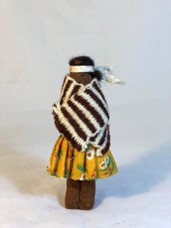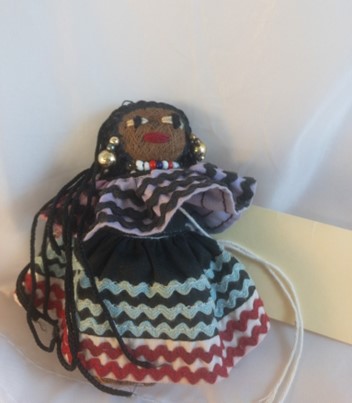
Kamentsá cultures, Putumayo region, Colombia
Mid-20th century
Wood, glass seed beads, cotton fabric, and pigment,
L 8.5 cm x W. 7cm x H. 45cm
Wilson collection #2019.18

Kamentsá cultures, Putumayo region, Colombia
20th century
Wood, paint, cotton and glass beads,
L. 16.5 cm x W. 6.4 cm x H. 40 cm
Wilson collection #2019.19
These two unusual wooden figures are from Colombia, and they are identifiable because of their traditional clothing to be depictions of people of the Kamentsá cultures from the Putumayo region of southern Colombia. The male figure wears a striped poncho over a dark undergarment, and he wears a necklace composed of multiple strands of beads. The female figure likewise wears many strands of seed beads, but her clothing consists of a dark skirt held up with a multi-colored belt around the waist, and over her shoulders she wears and brightly colored, blanket-like shawl with a contrasting border. Researched by Vanessa Lockhart and Hannah Dipoto

Great Plains region cultures
Late 20th century
Glass seed beads and nylon thread,
L. 3 cm x W. 2 cm x H. 4 cm
BFPC collection #2014.17a

Great Plains region cultures
Late 20th century
Glass seed beads and nylon thread,
L. 1.9 cm x W. .6 cm x H. 4.5 cm
BFPC collection #2014.17b
Beadwork is an important artform among the Great Plains cultures of North America and Canada. Early cultures of this region crafted beads from shell, bone, and porcupine quills to create jewelry and to embellish their leatherwork. When European cultures introduced tiny glass seed beads to this region, Great Plains cultures embraced the wide variety of colors that the beads provided, along with their relative ease of use. While specific color combinations could once be used to identify work by individual cultures, the widespread trade of ideas, motifs, and patterns among Great Plains artisans has rendered such identifications much less reliable.
These two small beaded figures were made for the tourist trade by Native artisans using a traditional peyote stitch, which is often used to create cylindrical forms. Although the colors used are not specific to an individual culture, the figures are identifiable as Great Plains cultures by the simplified depictions of their clothing. The male figure wears a headdress similar to a Great Plains feathered war bonnet; the female figure, meanwhile, wears a hat and a long fabric skirt, clothing that was adopted from European cultures and embraced by these cultures. Researched by Vanessa Lockhart and Hannah Dipoto

Hopi culture
Late 21st century
Wood, paint, feather, and acrylic pompoms,
L. 6.4 cm x W. 1.3 cm x H. 9.5 cm
BFPC collection #2003.21

Navajo/Dine culture
21st century
Wood, leather, bird feathers, pipe cleaners, and paint,
L. 3.5 cm x W. 3 cm x H. 9.8 cm
BFPC collection #2003.20a
The religion of the Pueblo peoples of the American Southwest includes a belief in kachinas, or katsinam, which are benevolent nature spirits. Men of the Hopi culture carve and paint wooden figures of these kachina spirits, known as tithu, to give to girls during the kachina season, so that girls may learn all of the different spirits. The Baby Kachina Figure is a good example of simplest of these figures, which consist of flat, rectangular painted figures with minimal decoration that are given to babies or toddlers.
The Navajo, also known as the Dine, adopted some of Pueblo religious practices after they moved into the Southwest, but they adopted the making of kachina figures primarily to create art objects for sale in the tourist trade. Like the Eagle Kachina Figure, Navajo kachina figures are generally depictions of kachina dancers, and these likewise tend to be more active and more naturalistic than the Pueblo tithu that are used as teaching tools. Navajo figures also tend to incorporate many different materials such as multiple feathers, leather, cloth, yarn, and even pipe cleaners in their figures, as opposed to Hopi figures, which primarily consist of painted wood. Researched by Vanessa Lockhart and Hannah Dipoto

Chancay culture (textiles), Peruvian culture (doll)
11th-14th century (textiles), 20th century (doll)
Wool cloth with embroidered details, L. 5.7 cm x W. 3 cm x H. 26.5cm
BFPC collection #2011.20
Chancay dolls are 20th-century figures made for the tourist trade using scraps of textiles made by the Chancay, an ancient Andean culture that flourished from the 11th-14th centuries. These scraps of cloth are unfortunately the destroyed remains of Chancay funerary textiles that looters attempted to recover from the ancient cemeteries; because the destroyed textiles are quickly discarded, the scraps are often found blowing around the sand dunes. Women in the nearby communities gather these scraps and use them to create figures that they call Chancay dolls, and they sell these dolls in the tourist trade.
Because these figures wear Chancay textile fragments, Chancay dolls may be mistaken for the funerary soft sculptures that were actually made by the Chancay. These two types of figures are easily distinguished from one another, however, as Chancay dolls have embroidered faces, while ancient Chancay funerary figures have faces that are woven into the cloth. Researched by Vanessa Lockhart and Hannah Dipoto

Tarahumara cultures
20th century
Wood, polyester, hair, and cotton, L. 7.6 cm x W. 7.6 cm x H. 15.9 cm
BFPC collection #2014.24
While the Tarahumara live in what is today northern Mexico, they are one of the cultures of the American Southwest region. Like many indigenous cultures of the Southwest, during the mid-20th century the Tarahumara recognized the opportunity to make a living by producing art and crafts for the tourist trade. Tarahumara artisans traditionally carved animal and human figures out of local types of wood, and when tourists showed an interest in purchasing these figures, the potential source of income encouraged Tarahumara people of all ages and genders to create these figures for the tourist trade.
The colorfully patterned and pleated skirt on this figure resembles traditional Tarahumara women’s clothing. The brown and white knitted shawl and the headband are more mysterious, however, as these more closely resemble men’s garments; women’s shawls are generally much more colorful, and their head scarves are much fuller and resemble bandanas.
for plastic dolls begin to carve dolls from wood.
The practice of making these wooden figures for sale had tapered off by the 1970s, but then it was revived when Tarahumara girls learned to sew doll clothes for plastic dolls in school. The girls soon began to carve and clothe wooden figures, and these instantly became popular in the tourist trade. Researched by Hannah Dipoto

Seminole culture
Late 20th century
Palmetto fibers, cotton, glass seed beads, plastic beads, L. 4.5 cm x W. 5cm x H. 8.5 cm
BFPC collection #2016.27
The earliest-known Seminole dolls were made in late 19th century by Seminole people from rags and sticks, and were meant to be used as toys for children. In the early 20th century, tourists began to travel through Florida to see the “exotic” scenery, and when they expressed interest in purchasing these dolls, and Seminole artisans began making and selling figures for the tourist trade as a way to help the financial security of their communities.
Early dolls were made by Seminole men, who carved them out of wood to create realistic figures; however, the Seminole people objected to this practice, as the Seminole believed that if a doll resembled a specific individual, then this figure could be used to bring harm to that person. The Seminole then began to make soft-sculpture dolls, such as this figure, from the fibers of the saw palmetto, and to dress the figures in traditional, colorful Seminole clothing. This new version of Seminole figures was avidly embraced by tourists, and the dolls continue to serve as a source of income for the Seminole peoples. Researched by Vanessa Lockhart
For more information, you may contact the researcher(s) noted in the title of this exhibit entry, or Dr. Billie Follensbee, the professor of the course, at BillieFollensbee@MissouriState.edu
